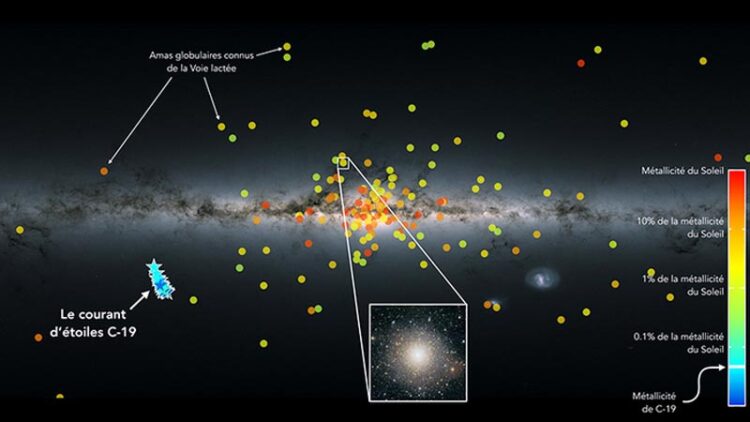Discovery of the least ‘metallic’ stellar structure in the Milky Way

Distribution of very dense groups of stars in the Milky Way, called globular clusters, superimposed on a map of the Milky Way compiled from data obtained with the Gaia Space Observatory. Each dot represents a cluster of a few thousand to several million stars, as in the insert image of the Messier 10 cluster. The colour of the dots shows their metallicity, in other words, their abundance of heavy elements relative to the Sun. The C-19 stars are indicated by the light blue symbols.
Credit: © N. Martin / Strasbourg Astronomical Observatory / CNRS; Canada-France-Hawaii Telescope / Coelum; ESA / Gaia / DPAC
98.5% of the Sun is made up of two light chemical elements, hydrogen and helium, while the remaining 1.5% consists of other heavier elements such as carbon, oxygen, and iron. The abundance of these heavier elements in a star is called its ‘metallicity’, and varies from star to star. It now turns out that our Galaxy is home to a stellar structure uniquely made of stars with extremely low metallicity, with a heavy element content 2,500 times lower than that of the Sun. This is well below that of any other known stellar structure in the Universe. This discovery1, made by an international team led by a CNRS researcher at the Strasbourg Astronomical Observatory (CNRS / University of Strasbourg), and involving scientists from the Galaxies, Stars, Physics and Instrumentation Laboratory (Paris Observatory – PSL / CNRS) and at the J-L Lagrange Laboratory (CNRS / Côte d’Azur Observatory), is published on January 5, 2022 in the journal Nature.
This group of stars all belong to a stellar structure in the Milky Way called C-19. Not only does this discovery challenge our current understanding and models of the formation of these stellar groupings, which exclude the existence of structures composed only of such stars, it also opens a unique and direct window onto the very earliest ages of star formation and the development of stellar structures in the very distant past. Since heavy elements were produced by successive generations of massive stars, the very low metallicity of the C-19 stars shows that they were formed only a short time after the birth of the Universe.
1- This work was carried out as part of the Pristine survey, with ESA’s Gaia space observatory, the Canada-France-Hawaii Telescope (Hawaii), the Gemini North telescope (Hawaii) and the GTC telescope (Canary Islands)
Journal: Nature
Article Title: A stellar stream remnant of a globular cluster below the metallicity floor
Article Publication Date: 5-Jan-2022
Media Contact
Francois Maginiot
CNRS
francois.maginiot@cnrs.fr
Office: 0033 144 964 309
All latest news from the category: Physics and Astronomy
This area deals with the fundamental laws and building blocks of nature and how they interact, the properties and the behavior of matter, and research into space and time and their structures.
innovations-report provides in-depth reports and articles on subjects such as astrophysics, laser technologies, nuclear, quantum, particle and solid-state physics, nanotechnologies, planetary research and findings (Mars, Venus) and developments related to the Hubble Telescope.
Newest articles

First-of-its-kind study uses remote sensing to monitor plastic debris in rivers and lakes
Remote sensing creates a cost-effective solution to monitoring plastic pollution. A first-of-its-kind study from researchers at the University of Minnesota Twin Cities shows how remote sensing can help monitor and…

Laser-based artificial neuron mimics nerve cell functions at lightning speed
With a processing speed a billion times faster than nature, chip-based laser neuron could help advance AI tasks such as pattern recognition and sequence prediction. Researchers have developed a laser-based…

Optimising the processing of plastic waste
Just one look in the yellow bin reveals a colourful jumble of different types of plastic. However, the purer and more uniform plastic waste is, the easier it is to…


